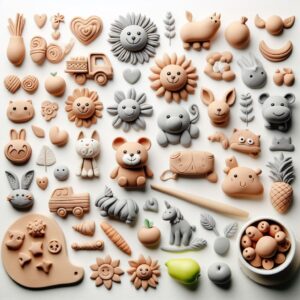Table Of Contents
- 1 Is Clay Sculpting Toxic? A Closer Look at the Safety of Popular Clays
- 1.1
- 1.2 Understanding Toxicity Levels:
- 1.3 Minimizing Risks:
- 1.4 Demystifying the Toxicity of Popular Sculpting Clays
- 1.5 1. Polymer Clay:
- 1.6 2. Air-Dry Clay:
- 1.7 3. Natural Clays:
- 1.8 4. Ceramic Clays:
- 1.9 Safe Sculpting: Addressing FAQs and Exploring Resources
- 1.10 Frequently Asked Questions:
- 1.11 5. What if I experience health concerns after using clay?
- 1.12 Shaping Safe and Creative Journeys: Clay Sculpting for Everyone
- 1.13 Key Takeaways:
- 1.14 Additional Resources:
Is Clay Sculpting Toxic? A Closer Look at the Safety of Popular Clays

The delicate touch of clay, its malleability and response to gentle pressure, has captivated artists and hobbyists for centuries. From intricate figurines to decorative pottery, clay sculpting offers an avenue for creative expression and artistic exploration. However, a common concern often arises – is sculpting clay toxic?
Before delving into the question of toxicity, it’s important to understand the different types of sculpting clays available. Each type possesses unique characteristics and potential health risks:
-
Polymer Clay: This versatile clay, often marketed as “oven-bake clay,” can be molded and shaped without requiring a kiln. However, polymer clay contains plasticizers, which are chemicals used to soften the material. While major brands of polymer clay have been tested and are certified to be non-toxic when used as directed, it’s important to avoid inhaling fumes during baking and thoroughly wash hands after handling.
-
Air-Dry Clay: This clay dries at room temperature, eliminating the need for baking. While generally considered non-toxic, some air-dry clays may contain small amounts of silica, which can be harmful if inhaled in large quantities. It’s important to follow the manufacturer’s instructions and work in a well-ventilated area.
-
Natural Clays: These clays come directly from the earth and can be found in various forms. While generally safe, some natural clays may contain trace amounts of harmful minerals like lead or arsenic. It’s crucial to purchase natural clays from reputable sources and research their safety profile before use.
-
Ceramic Clays: These clays require firing in a kiln to achieve their final form. While the firing process can release some potentially harmful fumes, ceramic clays are generally considered safe when handled properly. It’s crucial to follow kiln safety guidelines and wear appropriate protective gear.
Understanding Toxicity Levels:
The potential toxicity of sculpting clay depends on several factors, including:
- Type of clay: As mentioned, different types of clay contain varying levels of potentially harmful substances.
- Exposure: The amount of clay handled and the duration of exposure play a significant role in determining potential health risks.
- Individual sensitivity: Some individuals may be more sensitive to certain chemicals found in clay than others.
Minimizing Risks:
While some types of clay may pose potential health risks, there are several steps you can take to minimize these risks:
- Choose non-toxic clays: Opt for brands certified to be safe and free of harmful chemicals.
- Work in a well-ventilated area: This helps reduce exposure to potentially harmful fumes.
- Wear gloves and a mask: This protects your hands and respiratory system from contact with clay dust and fumes.
- Wash hands thoroughly: This is especially important after handling clay and before eating or drinking.
- Store clay properly: Keep clay sealed and out of reach of children and pets.
By following these safety guidelines and choosing non-toxic clays, you can enjoy the creative pleasure of sculpting clay while minimizing potential health risks.
In the next, we’ll explore the specific safety profiles of different sculpting clays, providing you with detailed information to make informed choices for your artistic endeavors.
Demystifying the Toxicity of Popular Sculpting Clays
In the previous session, we explored the diverse types of sculpting clays and highlighted the importance of understanding potential toxicity concerns. Now, let’s delve deeper into the specific safety profiles of popular clay options, empowering you to make informed choices for your creative journey.
1. Polymer Clay:
- Safety: Major brands of polymer clay are generally considered non-toxic when used as directed. They are certified to comply with international safety standards, such as the American Society for Testing and Materials (ASTM) F963.
- Potential Concerns: Plasticizers used in polymer clay can release fumes during baking. These fumes can irritate the eyes and respiratory system.
- Safe Handling Tips:
- Use a dedicated oven for baking polymer clay to avoid cross-contamination with food.
- Bake in a well-ventilated area and avoid inhaling fumes.
- Wash hands thoroughly after handling polymer clay.
2. Air-Dry Clay:
- Safety: Air-dry clays are often considered non-toxic, especially for children. However, some brands may contain small amounts of silica, which can be harmful if inhaled in large quantities.
- Potential Concerns: Silica dust can irritate the respiratory system, particularly for individuals with pre-existing conditions like asthma.
- Safe Handling Tips:
- Work in a well-ventilated area.
- Wear a mask, especially when sanding or generating dust.
- Choose air-dry clays specifically formulated to be dust-free.
3. Natural Clays:
- Safety: Natural clays can be safe if sourced from reputable suppliers. However, they may contain naturally occurring minerals like lead or arsenic, which can be toxic if ingested or inhaled in large quantities.
- Potential Concerns: The specific mineral content of natural clays can vary significantly.
- Safe Handling Tips:
- Purchase natural clays from reputable sources that provide safety information.
- Research the specific clay type before using it.
- Wear gloves and a mask when handling natural clays.
4. Ceramic Clays:
- Safety: Ceramic clays are generally considered safe when handled properly. However, the firing process can release potentially harmful fumes, including lead and silica.
- Potential Concerns: Exposure to kiln fumes without proper ventilation can lead to respiratory problems.
- Safe Handling Tips:
- Use a well-ventilated kiln room or area.
- Wear appropriate respiratory protection, such as a respirator or mask.
- Avoid contact with fired ceramics until they have cooled completely.
Remember: This information is not exhaustive and specific safety recommendations may vary by brand and clay type. Always refer to the manufacturer’s safety guidelines for detailed instructions and precautions.
In next, we’ll expand our exploration of clay sculpting safety by addressing frequently asked questions and providing additional resources.
Safe Sculpting: Addressing FAQs and Exploring Resources

In our previous sessions, we explored the diverse types of sculpting clays, their potential toxicity concerns, and safe handling practices. Now, let’s delve deeper by addressing frequently asked questions and providing valuable resources to guide your safe and enjoyable sculpting journey.
Frequently Asked Questions:
1. Are there any clays that are completely non-toxic?
While some clays are considered “non-toxic” based on current safety standards, it’s important to note that complete non-toxicity is difficult to guarantee. Even natural clays can contain trace amounts of potentially harmful minerals.
2. Is it safe for children to use sculpting clay?
Many types of sculpting clay, particularly air-dry and polymer clays labeled as “non-toxic,” can be safe for children with proper adult supervision. However, it’s crucial to choose age-appropriate clays and ensure children follow safe handling practices like washing hands thoroughly.
3. What are some alternatives to traditional sculpting clays?
Several safe alternatives exist, such as:
- Modeling dough: This non-toxic dough is often made from natural ingredients and air-dries without requiring baking.
- Salt dough: This simple dough recipe uses readily available ingredients like flour, salt, and water.
- Paper clay: This versatile material is made from recycled paper and can be air-dried or baked.
4. Where can I find more information about clay sculpting safety?
Numerous resources are available online and in libraries, including:
- Manufacturer websites: Most clay manufacturers provide safety information and handling instructions on their websites.
- Art supply stores: Staff at art supply stores can offer guidance and recommendations on safe clays and handling practices.
- Arts and crafts websites: Many online resources offer information about clay sculpting, including safety tips and tutorials.
- Government websites: The Occupational Safety and Health Administration (OSHA) and the Environmental Protection Agency (EPA) provide information about hazardous materials, including potential risks associated with clay sculpting.
5. What if I experience health concerns after using clay?
If you experience any health concerns, such as irritation or breathing difficulties, after using clay, seek medical attention immediately. It’s important to inform the healthcare professional about the type of clay you were using and the circumstances of your exposure.
By staying informed, choosing safe clays, and following proper handling practices, you can enjoy the creative freedom and therapeutic benefits of clay sculpting while minimizing potential health risks.
In next, we’ll summarize key takeaways and offer additional resources to empower you to embark on a safe and enriching journey into the world of clay sculpting.
Shaping Safe and Creative Journeys: Clay Sculpting for Everyone
As we conclude our exploration of clay sculpting safety, let’s summarize key takeaways and offer additional resources to equip you with the knowledge and confidence to embark on a safe and enriching creative journey with clay.
Key Takeaways:
- Understanding the different types of sculpting clays and their potential toxicity concerns is crucial for making informed choices.
- While major brands of polymer clay are generally considered non-toxic, proper ventilation and safe handling practices are essential.
- Air-dry clays are often safe for children, but choosing dust-free varieties and working in a well-ventilated area is recommended.
- Natural clays may contain trace amounts of harmful minerals, so sourcing them from reputable sources and researching their safety profile is crucial.
- Ceramic clays require kiln firing, which releases potentially harmful fumes. Proper ventilation and respiratory protection are essential during firing.
- Always refer to the manufacturer’s safety guidelines for detailed instructions and precautions specific to each clay type.
Additional Resources:
- Art Hazards Information Center: https://www.wildlifeart.org/about/contact
- American Society for Testing and Materials (ASTM): https://www.astm.org/
- Occupational Safety and Health Administration (OSHA): https://www.osha.gov/
- Environmental Protection Agency (EPA): https://www.epa.gov/
- National Council on Education for the Ceramic Arts (NCECA): https://nceca.net/
By prioritizing safety, choosing appropriate clay types, and practicing good hygiene, you can unlock the transformative power of clay sculpting while ensuring a safe and enjoyable creative experience for yourself and others.
Remember, the journey into the world of clay sculpting is an exciting adventure filled with limitless possibilities. By embracing knowledge, promoting safe practices, and nurturing your artistic spirit, you can transform your creative vision into beautiful and lasting expressions of art.

